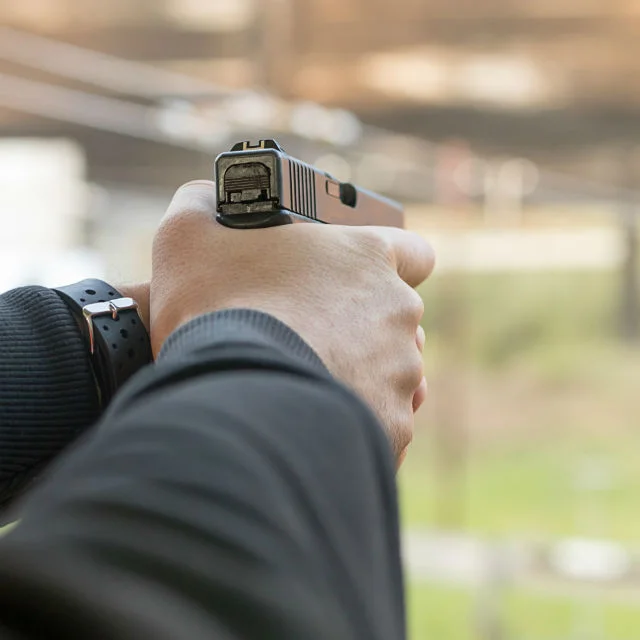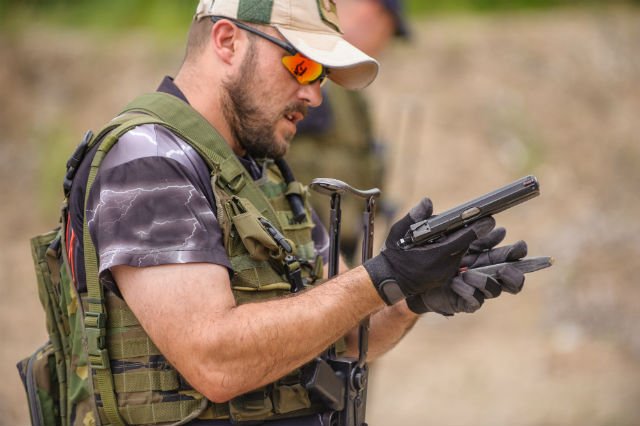6 Dry Fire Training Drills While You're Stuck At Home

Dry Fire Drills To Help Get Your Skills Up
We all know that dry fire is how you work on those fundamental skills to make us better shooters. Okay, great. What exercises help you do that?
There are a great many out there, but here are 6 that will help you work on a number of different fundamental skills. Bear in mind, of course, that dry fire has to be accompanied at some point with live fire, which dry fire is no replacement for.
PLEASE BE SAFE!!! Dry fire should be done with NO AMMUNITION in or near the gun. In fact, try to do any dry fire training in a room that has no ammunition in it. Clear, check, and re-check. Visually inspect the chamber to ensure no ammunition is in the gun.
So while you can't go to the shooting range, here are some excellent dry fire training drills that can help you get better at whatever aspect of your shooting that you're trying to improve at.
The Balance Drill: Dry Fire For Trigger Control
To work on trigger control, a great dry fire drill is what's called the "balance drill." It's rather simple, and it can help you work on trigger control, which is a huge part of good shooting.
First, make sure your pistol is totally cleared. In fact, make sure all ammunition is in a different room if possible.
So, how it works is that you balance a small object on the top of the slide or top strap if you're using a revolver. An empty shell casing, a coin, a thumb tack, whatever. It doesn't entirely matter, just as long as it's small enough to move if the gun moves but can balance on top of it.
The best way to do this is with the muzzle barely away from the wall, with your pistol presented as normal, and then place the object on the gun. Get your firing grip, and then press the trigger. The object shouldn't move.
The goal of this drill is to pull the trigger without the object moving. If it's moving, that means you need to hone your trigger press and your grip.
Simple Dry Fire

The simplest dry fire exercise is just to get the sights on target and press the trigger. Sight picture, squeeze. That's it.
The best thing to do is to put up a very small target, as small as possible, on the wall, or pick something very, very small on the wall or on some sort of furniture that you can use as a target. Get it in your sights, and squeeze the trigger. The gun should not come off the target, or at least shouldn't come off the target much.
If you've taken SHOT IQ, this is where you put in practice.
You should practice shooting with a full shooting grip, and also with the dominant and weak hands only. Here's how you can get the dominant and weak hand only skills in working order without wasting ammo.
Simple, slow aimed shots with all the proper fundamentals being exercised is all you're doing. Remember, it isn't practice makes perfect; it's perfect practice that makes perfect.
Presentation: The Easiest Dry Fire Drill
Another simple dry fire drill, which is solely about the basics, is to practice presentation along with the trigger press. The goal of the drill is to work on picking up the target and a sight picture, and then pressing the trigger.
Start at a low-ready position, with a good firing grip. Present the pistol to the target and dry fire once. It's really not terribly complicated; it's a meat and potatoes exercise that works the most basic of basics. And that's the stuff you need to have down if you want to prevail in a fight.
Of course, the gun must be totally clear of ammunition. You should also put up a small target, such as a small sticky dot from one of those "peel and stick" targets. Ideally, about an inch in diameter.
As with anything else, start slow. You want to become smooth and efficient before you worry about getting fast. Smooth, after all, leads to fast. Eventually you can start incorporating a timer but to start with, just go slow and smooth.
Target Transition Dry Fire Drill

Obviously, you can't simulate recoil in dry fire - unless you get a recoil simulation system, which is a topic for another time - but you can still work on target transitions.
You'll need to have two targets. Starting from the low ready, present the pistol to the first target, press the trigger, then transition to the second target, acquire a sight picture and then press a second time.
The goal is getting off the first target to the second, smoothly transitioning and then getting a sight picture and pressing the trigger all over again. Bear in mind that doing this with live ammunition is a whole lot different in that you'll have to add recoil into the mix, but it gives you some groundwork for transitioning between targets.
The First Shot Dry Fire Drill

If you're carrying a concealed handgun, you may need to come out of the holster firing to put the threat down. In fact, you may only have time for a single shot. Here's how you practice putting that shot on target without ammunition.
Start with your pistol - unloaded!!! - in your concealed carry holster, wearing the clothes that you normally wear.
Clear your cover garment, then draw and present the pistol. Build your firing grip in the presentation and then get your sights on target and press the trigger. Draw, then shoot.
If you concealed carry, this needs to be part of your regular practice routine. IF you ever have to use your gun in defense of yourself, this is likely how it will be used. Practice it. Then practice it some more.
Remember, slow is smooth and smooth is fast. Practice slowly but efficiently, and do so repeatedly. Eventually, you can work in a timer to start building up speed, but don't worry about it at first; you want to get the muscle memory down.
The Dry Fire Reload

You'll need at least two empty magazines - AND THEY MUST BE EMPTY! - to practice a dry fire reload. The goal here is obviously to drill a reload. While this will be different than practicing a reload on the range, you can still work some of the fundamentals.
Technically, this will be closest to a tactical reload/IPSC reload rather than a slide lock reload. We can get into the differences some other time, but suffice to say that you should be able to do both. Obviously, you won't get a slidelock during dry fire, but you should definitely practice slide lock reloads as part of your practice regimen.
You start with your sights on target with an empty magazine in the pistol. Press the trigger as you would normally. After the click, rotate the pistol up towards your face, while keeping your eyes on the target, and press the magazine release.
Insert the second - EMPTY! - magazine and seat it, only taking your eyes off the target long enough to get the second magazine into the magazine well. Get your eyes back on target, and then get the sights back on target, and then dry fire again.
Just as with the others, start slow and efficient, until you've noticed that you're definitely running this drill faster. THEN start adding a timer into the equation if you want to.
Reloads are another critical skill, both for topping off the pistol in a tactical environment, if you happen to shoot it dry, or also for clearing malfunctions. Again, we can talk about the different types of reloads at a later date, but this is how you can practice reloading without having to burn ammunition.









